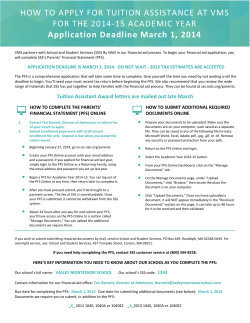
Maintenance in Lung cancer – Yes ? Dr. Ryvo Larisa TASMC
Maintenance in Lung cancer – Yes ? Dr. Ryvo Larisa TASMC Maintenance of early second line Maintenance therapy : continuing the treatment or part of the it until PD Early second line: introducing a new agent without PD Definitions Maintenance therapy Defined tumor response Defined no. of cycles Defined time or until PD • Extension of treatment duration by administration of ≥1 agents after a defined no. of treatment cycles • Patients must demonstrate a defined tumor response to be eligible Sequential therapy Defined no. of cycles Defined no. of cycles • Therapy for a defined no. of cycles, followed by a different therapy for a defined no. of cycles • Switch between therapies does not require documented disease progression vs. regular switch from 1st- to 2nd-line treatment Grossi et al. Oncologist 2007;12:451–464 In recent studies, approximately 50% of patients did not receive second-line therapy Socinski et al. 20021 Belani et al. 20032 Brodowicz et al. 20063 von Plessen et al. 20064 Barata et al. 20075 Park et al. 20076 Ciuleanu et al. 20097 Pirker et al. 20088 Scagliotti et al. 20089 Fidias et al. 200910 0 25 50 75 Patients receiving 2nd-line therapy (%) 1. J Clin Oncol 2002;20:1335–43; 2. J Clin Oncol 2003;21:2933–39; 3. Lung Cancer 2006;52:155–63; 4. Br J Cancer 2006;95:966–73; 5. J Thorac Oncol 2007;2(Suppl. 4):S666 (Abs. P2-235); 6. J Clin Oncol 2007;25:5233–39; 7. Lancet 2009;374:1432–40; 8. J Clin Oncol 2008;26(Suppl. 15):6s (Abs. 3); 9. J Clin Oncol 2008;26:3543–51; 10. J Clin Oncol 2009;27:591–98 100 Delaying further therapy is not a viable option for a large group of patients 100 46% do not receive 2L therapy 80 17% die before decision is made 60 29% only receive BSC 100% 40 Main reasons 54% Poor PS (58%) Poor response to 1L (24%) Co-morbidities (24%) Extent of disease (22%) 20 0 Pts receiving 1L therapy Pts receiving 2L therapy TNS Healthcare, Brand Tracking Study, December 2007 Data from study involving 306 EU physicians Maintenance chemotherapy 1. Cytotoxics • Gemcitabine • Docetaxel • Pemetrexed 2. Small Molecule • Erlotinib 3. Antibody Erbitux Bevacizumab Immediate vs delayed docetaxel Fidias, et al. ASCO 2007; Abstract No. LBA7516 Immediate vs delayed docetaxel Immediate (n=153) Delayed P-value (n=154) TTP (mo) 6.5 2.8 <0.001 OS (mo) 11.9 9.1 0.071 20/46/17 0.34 QoL I/S/W 17/57/14 I, improved; S, stable; W, worsened Fidias, et al. ASCO 2007; Abstract No. LBA7516 Pem/BSC vs placebo/BSC in NSCLC: Sequential study design Stage IIIB/IV NSCLC PS 0/1 Pemetrexed 500 mg/m2 (d1,q21d) + BSC (N=441)* 4 prior cycles of gem, doc, or tax + cis or carb, with CR, PR, or SD (NO PEMETREXED) Randomization factors: gender PS stage best tumor response to induction non-platinum induction drug brain mets 2:1 Randomization Primary Endpoint = PFS Placebo (d1, q21d) + BSC (N=222)* *B12, folate, and dexamethasone given in both arms Ciuleanu, et al. Presented at: Annual Meeting of the American Society of Clinical Oncology, June 2, 2008; Chicago, IL. Objectives Primary Objective Progression-free survival Secondary Objectives Overall survival Objective response rate (CR+PR) Disease control rate (CR+PR+SD) Safety and toxicity profile Pem/BSC vs placebo/BSC in NSCLC: PFS Progression-free Probability 1.0 N=581 HR=0.599 (95% CI: 0.49–0.73) p <0.00001 Pemetrexed: 4.04 mos (95% CI: 3.06–4.44) Placebo: 1.97 mos (95% CI: 1.54–2.76) Time (months) 24% censored Ciuleanu, et al. Presented at: Annual Meeting of the American Society of Clinical Oncology, June 2, 2008; Chicago, IL. Overall Survival (ITT) HR=0.79 (95% CI: 0.65–0.95) P =0.012 1.0 Survival Probability 0.9 0.8 0.7 0.6 0.5 Pemetrexed 13.4 mos 0.4 Placebo 10.6 mos 0.3 0.2 0.1 0.0 0 3 6 9 12 15 18 21 24 27 30 33 36 39 42 45 48 Time (months) Progression-free Survival by Histology Progression-free Probability Nonsquamous Squamous HR=0.47 (95% CI: 0.370.6) P <0.00001 1.0 0.9 0.8 0.7 0.6 0.5 0.4 0.3 0.2 0.1 0.0 1.0 0.9 0.8 0.7 0.6 0.5 0.4 0.3 0.2 0.1 0.0 Pemetrexed 4.4 mos Placebo 1.8 mos 0 3 6 9 12 15 Time (months) HR=1.03 (95% CI: 0.771.5) P =0.896 18 21 24 Pemetrexed 2.4 mos Placebo 2.5 mos 0 3 6 9 12 15 Time (months) 18 21 24 SATURN – a prospective phase III study of Tarceva as maintenance Tarceva 150mg/day Chemonaïve advanced NSCLC n=1,949 4 cycles of firstline platinum doublet chemotherapy Non-PD n=889 PD 1:1 Placebo PD Mandatory tumour sampling Stratification factors: • • • • • • EGFR IHC (positive vs negative vs indeterminate) Stage (IIIB vs IV) ECOG PS (0 vs 1) CT regimen (cis/gem vs carbo/doc vs others) Smoking history (current vs former vs never) Region Cappuzzo, ASCO 2009 Co-primary endpoints: • PFS in all patients • PFS in patients with EGFR IHC+ tumours Secondary endpoints: • OS in all patients and those with EGFR IHC+ tumours, OS and PFS in EGFR IHC– tumours; biomarker analyses; safety; time to symptom progression; QoL Tarceva significantly prolongs OS in all patients (ITT) 1.0 HR=0.81 (0.70–0.95) OS probability 0.8 Log-rank p=0.0088 0.6 Erlotinib (n=438) Placebo (n=451) 0.4 0.2 11.0 0 0 3 6 9 12.0 12 15 18 21 Time (months) *OS is measured from time of randomisation into the maintenance phase; ITT = intent-to-treat population Cappuzzo, WCLC 2009 24 27 30 33 36 OS in patients with SD on first-line chemotherapy according to histology 1.0 Squamous-cell HR=0.67 (0.48–0.92) OS probability 0.8 Log-rank p=0.0116 0.6 Erlotinib (n=97) Placebo (n=93) 0.2 0.2 0 0 3 6 9 12 15 18 21 24 27 30 33 36 Time (months) Measured from time of randomisation into the maintenance phase Log-rank p=0.0457 Erlotinib (n=155) Placebo (n=142) 0.6 0.4 11.3 HR=0.76 (0.59–1.00) 0.8 0.4 8.3 Non-squamous 1.0 0 10.6 13.7 0 3 6 9 12 15 18 21 24 27 30 33 36 Time (months) OS* according to response to first-line chemotherapy SD CR/PR 1.0 1.0 HR=0.72 (0.59–0.89) OS probability 0.8 HR=0.94 (0.74–1.20) 0.8 Log-rank p=0.0019 0.6 Log-rank p=0.6181 0.6 Erlotinib (n=184) Erlotinib (n=252) 0.4 Placebo (n=235) 0.2 0 Placebo (n=210) 0.4 0.2 9.6 0 3 6 11.9 9 12 15 18 21 24 27 30 33 36 0 12.0 12.5 0 3 6 Time (months) *OS is measured from time of randomisation into the maintenance phase 9 12 15 18 21 24 27 30 33 36 Time (months) SATURN: All patient subgroups obtains significant PFS benefit from Tarceva All HR (95% CI) 0.71 (0.62–0.82) n 884 Male 0.78 (0.66–0.92) 654 Female 0.56 (0.42–0.76) 230 Caucasian 0.75 (0.64–0.88) 744 Asian 0.58 (0.38–0.87) 128 Adenocarcinoma 0.60 (0.48–0.75) 401 Squamous-cell 0.76 (0.60–0.95) 359 Never smoker 0.56 (0.38–0.81) 152 Former smoker 0.66 (0.50–0.88) 242 Current smoker 0.80 (0.67–0.97) 490 0.4 Cappuzzo, ASCO 2009 0.6 0.8 1.0 1.2 Favours Tarceva HR Favours placebo Symptom benefits and no impairment of QoL with maintenance Tarceva Time to . . . HR (95% CI) p value Deterioration in QoL* 0.96 (0.79–1.16) 0.65 Pain‡ 0.61 (0.42–0.88) 0.01 Opioid or analgesic§ 0.66 (0.46–0.94) 0.02 Dyspnoea‡ 0.75 (0.48–1.17) 0.21 Cough‡ 0.77 (0.49–1.21) 0.25 *Assessed using Functional Assessment of Cancer Therapy – Lung (FACT-L) questionnaire ‡Data from AE records §Data from concomitant medication records Cappuzzo F, et al. J Thorac Oncol 2009;4(9 Suppl. 1):S289 (Abs. A2.1) Conclusions • Maintenance (chemo) therapy – Improves PFS – Improves OS – Toxicity issues – QoL? • Choice of maintenance (chemo)therapy? • TKI Which patients have the greatest clinical need for maintenance therapy? • Patients with the greatest need for maintenance therapy are those with – sub-optimal response to first-line chemotherapy – remaining disease symptoms – less chance to receive subsequent therapy – worse overall prognosis patients with SD following first-line chemotherapy PARAMOUNT (S124): Study Design A Phase 3, Double-Blind, Placebo-Controlled Study of Maintenance Pemetrexed Plus Best Supportive Care Versus Best Supportive Care Immediately Following Induction Treatment With Pemetrexed + Cisplatin for Advanced Nonsquamous NSCLC MaintenanceTherapy Induction Therapy Pemetrexed 500 mg/m2, day 1 Cisplatin 75 mg/m2, day 1 every 21 days x 4 cycles Primary Objective: Secondary Objective: PFS OS Patient-Reported Outcomes Resource Utilization Adverse Events Serious Adverse Events Objective Tumor Response Rate (whole treatment, maintenance) R A N D O M I Z E If CR, PR, SD Pemetrexed 500 mg/m2, day 1 every 21 days + Best Supportive Care Placebo, day 1 every 21 days + Best Supportive Care Maintenance in Lung cancer – Yes !
© Copyright 2025





















